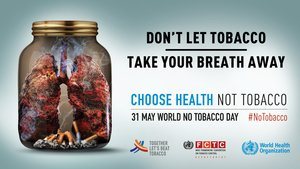The WHO, bless their cotton socks, in December 2020 launched a ‘year-long global campaign for World No Tobacco Day 2021, “Commit to Quit”, and as part of this splendid effort we’re informed that ‘The campaign will support at least 100 million people as they try to give up tobacco.’
Come now, Dr Symonds, surely this is not going to be another of your satirical put-downs!
My apologies, but the dear old WHO just doesn’t get it.
From the start, the very phrase ‘Commit to Quit’ is wrong. Committing to quitting sounds all very well, but when is this vast number of 100 million smokers actually going to do it? As the proverb had it, the road to hell is paved with good intentions. What smokers need to do is to quit right now. If they merely commit themselves to quitting, this means they intend to do it some time in the future, such as on that special day of 31st May 2021, but what will they be doing in the meantime? Smoking! And even in the unlikely event they can conjure up the willpower to refrain from poisoning themselves with tobacco fumes on that singular day, what then? What will happen on 1st June and subsequently? In all likelihood they’ll start smoking again, though probably with a worse conscience.
As the fateful date of 31st May was announced almost six months in advance, in a sense it gives smokers permission to carry on smoking in the meantime. This merely reinforces the illusions under which so many smokers labour, that a) there’s something wonderful about smoking which they might as well enjoy up till the last minute, and b) that ceasing to inhale tobacco smoke is terribly, terribly difficult, thus reinforcing smokers’ inherent reluctance to quit.
Then we’re told that ‘the COVID-19 pandemic has led to millions of tobacco users saying they want to quit.’
Here we go again. It’s meaningless for tobacco users, even millions of them – or especially millions of them – merely to say they want to quit. The important question is: when are they going to do it? On 31st May, on New Year’s Day, or…never?
Ambitious
Further, WHO breezily tells us that ‘The campaign will support at least 100 million people as they try to give up tobacco through communities of quitters.’
You can’t say WHO isn’t ambitious in their professed intention to support, whatever that means, such a vast number who are going to try to give up tobacco. And what are these sad communities of quitters? We aren’t told, but like Groucho Marx to whom is attributed the saying, ‘I wouldn’t want to belong to a club that would have me for a member,’ I don’t think I would want to be part of a community with such an uncomplimentary name. In any case, what’s the good of merely trying to give up tobacco? This means failing to give up, as is demonstrated every time a smoker lights another cigarette. It’s the trying that’s the problem. What’s needed is for smokers to stop trying to quit smoking – and just quit!
Campaign based on fear
The whole thrust of WHO’s campaign is based on fear. They’re saying, in effect, ‘If only smokers realised they harm they’re doing to themselves, to others, and to the environment, then they would of necessity quit.’ And to rub it in they give a list of ‘More than 100 reasons to quit tobacco,’ 103 of them to be precise, and all negative. We’re regaled with the well-known facts that smoking stinks, causes cancer, increases your chances of dying from Covid-19, makes your face wrinkled, and is a bad example for your kids.
Smokers don’t smoke because of ignorance of the effects of poisoning themselves with tobacco fumes. They smoke because of drug addiction, the drug, of course, being nicotine. Yet the word ‘addiction’ is notable by its absence from all the 103 reasons and elsewhere on the website. And WHO Director-General, Dr Tedros Adhanom Ghebreyesus, who ought to know better, calls smoking a habit which he believes, if only smokers had sufficient motivation, they could kick.
Everybody – or nobody – wants to quit
We’re also encouragingly reminded that ‘Quitting tobacco is challenging’ and that ‘Worldwide around 780 million people say they want to quit, but only 30 per cent of them have access to the tools that can help them do so.’
How do they know that 780 million people say they want to quit? Have they asked them? Is this multitude crying out, ‘WHO help us! We want to quit tobacco use but lack access to the tools to do so. We implore you, give us access to these tools!’
One may wonder, even for the 30 per cent who apparently do have access to the magic tools, why are they still smoking? And where does this nice round figure of 30 per cent come from? It’s a meaningless shibboleth that’s copied from one journal article or internet site to another, the origin of which, as far as I can discover, is from the British 1998 General Household Survey. The figure derived depends on how you ask the question, as I describe in Chapter 2, ‘Everybody Wants to Quit – Nobody Wants to Quit’, of my book Stop Smoking: Real Help at Last.
Reduce – or abolish – the demand for tobacco?
The WHO announcement ends on a self-congratulatory note: ‘To create environments conducive to quitting tobacco, WHO has worked with partners and countries around the globe to implement tobacco control measures that effectively reduce the demand for tobacco.’
How much reduction in the demand for tobacco would WHO be satisfied with? And what about all those unfortunate people who are unable to curtail their demand? Are they beyond help?
Rather than campaigning merely for a reduction in the demand for tobacco, why does WHO not grasp the bull by the horns and campaign for its abolition by banning the manufacture and sale of tobacco products?
World No Tobacco Day indeed! Every day should be a no tobacco day.
Text © Gabriel Symonds


Leave A Comment